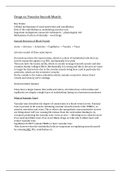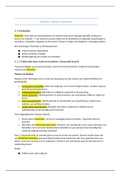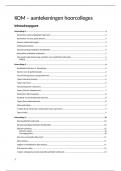Drugs on Vascular Smooth Muscle
Key Points:
Cellular mechanisms of vasoconstriction and vasodilation
Role of the endothelium in modulating vascular tone
Important endogenous vasoactive substances – physiological role
Mechanism of action of clinically – used drugs
General Structure of Blood Vessels
Aorta -> Arteries -> Arterioles -> Capillaries -> Venules -> Veins
Arteries consist of three main layers:
On inside you have the tunica intima, which is a sheet of endothelial cells that can
secrete vasoactive agents (e.g. NO), mechanically it is weak.
Then you have the tunica media, which is circular arranged smooth muscle and also
contains elastin/collagen fibres. Mechanically it is strong and this is the area we want
to target for this lecture due to the circular muscle being here (and in particular the
arterioles, which are the restrictive vessels)
On the outside is the tunica adventitia which contains connective tissue, blood
vessels and sensory nerve endings.
[Internal elastic lamina]
Veins have a larger lumen, thin walls and valves, arterioles have a thin intima and
capillaries are simply a single layer of endothelium laying on a basement membrane.
What is Vascular Tone?
Vascular tone describes the degree of constriction of a blood vessel at rest. Vascular
tone is present in all vessels containing vascular smooth muscle cells (VSMCs), so
arteries, arterioles and veins. This is where the sympathetic vasoconstrictive nerves
are firing about 1AP/sec causing NA release from the varicosities binding to α1
receptors producing the vascular tone (even at rest) -> Allowing us to constrict more
if we need and dilate more if we need. Many drugs we take aim to dilate more and
reduce vascular tone.
Capillaries do NOT contain VSMCs or have vascular tone.
Note however that the endothelial cells are important in regulating smooth muscle
by releasing NO, PGs, endothelins etc.
, What Controls Blood Flow Through Vessels -> Darcy’s Law
Darcy’s law of flow tells us:
Q = P1-P2
R
Where
Q= Flow
P1-P2 = Pressure difference
R = Resistance to flow
If we have excessive vascular tone and resistance increases, flow will be reduced.
This means end organs may not receive the blood supply they need, however this can
be overcome if we increase the pressure difference (if we increase greater pressure,
from the heart!) allowing us to maintain flow.
However this will come at a greater expenditure of energy so it is not an efficient
process (how long term high resistance can lead to heart failure).
Blood flow (CO) = Pa – CVP
TPR
Can be rearranged to->
Blood pressure (Pa) = CO x TPR
So we know that vascular resistance controls blood flow and blood pressure.
Poiseuille’s Law describes to us the parameters that govern vascular resistance
(building on Darcy’s law):
Blood flow = Pa – CVP x πr4
8ηL
Where
r = Radius of vessel
η = blood viscosity
L = vessel length
Key Points:
Cellular mechanisms of vasoconstriction and vasodilation
Role of the endothelium in modulating vascular tone
Important endogenous vasoactive substances – physiological role
Mechanism of action of clinically – used drugs
General Structure of Blood Vessels
Aorta -> Arteries -> Arterioles -> Capillaries -> Venules -> Veins
Arteries consist of three main layers:
On inside you have the tunica intima, which is a sheet of endothelial cells that can
secrete vasoactive agents (e.g. NO), mechanically it is weak.
Then you have the tunica media, which is circular arranged smooth muscle and also
contains elastin/collagen fibres. Mechanically it is strong and this is the area we want
to target for this lecture due to the circular muscle being here (and in particular the
arterioles, which are the restrictive vessels)
On the outside is the tunica adventitia which contains connective tissue, blood
vessels and sensory nerve endings.
[Internal elastic lamina]
Veins have a larger lumen, thin walls and valves, arterioles have a thin intima and
capillaries are simply a single layer of endothelium laying on a basement membrane.
What is Vascular Tone?
Vascular tone describes the degree of constriction of a blood vessel at rest. Vascular
tone is present in all vessels containing vascular smooth muscle cells (VSMCs), so
arteries, arterioles and veins. This is where the sympathetic vasoconstrictive nerves
are firing about 1AP/sec causing NA release from the varicosities binding to α1
receptors producing the vascular tone (even at rest) -> Allowing us to constrict more
if we need and dilate more if we need. Many drugs we take aim to dilate more and
reduce vascular tone.
Capillaries do NOT contain VSMCs or have vascular tone.
Note however that the endothelial cells are important in regulating smooth muscle
by releasing NO, PGs, endothelins etc.
, What Controls Blood Flow Through Vessels -> Darcy’s Law
Darcy’s law of flow tells us:
Q = P1-P2
R
Where
Q= Flow
P1-P2 = Pressure difference
R = Resistance to flow
If we have excessive vascular tone and resistance increases, flow will be reduced.
This means end organs may not receive the blood supply they need, however this can
be overcome if we increase the pressure difference (if we increase greater pressure,
from the heart!) allowing us to maintain flow.
However this will come at a greater expenditure of energy so it is not an efficient
process (how long term high resistance can lead to heart failure).
Blood flow (CO) = Pa – CVP
TPR
Can be rearranged to->
Blood pressure (Pa) = CO x TPR
So we know that vascular resistance controls blood flow and blood pressure.
Poiseuille’s Law describes to us the parameters that govern vascular resistance
(building on Darcy’s law):
Blood flow = Pa – CVP x πr4
8ηL
Where
r = Radius of vessel
η = blood viscosity
L = vessel length











